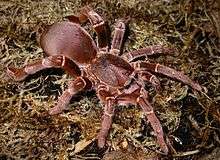King baboon spider
| King baboon spider | |
|---|---|
 | |
| Adult female | |
| Scientific classification | |
| Kingdom: | Animalia |
| Phylum: | Arthropoda |
| Subphylum: | Chelicerata |
| Class: | Arachnida |
| Order: | Araneae |
| Infraorder: | Mygalomorphae |
| Family: | Theraphosidae |
| Genus: | Pelinobius Karsch, 1885[1] |
| Species: | P. muticus |
| Binomial name | |
| Pelinobius muticus Karsch, 1885[1] | |
| Synonyms[1] | |
|
Genus: Citharischius Pocock, 1900 | |
The king baboon spider, scientific name Pelinobius muticus, is a tarantula species native to East Africa. It is the only species in the genus Pelinobius.[1] The king baboon spider can grow up to 20 cm in leg span. It is a slow-growing species. The spider is often rusty brown or orange in colour. As a burrowing species, the back legs are very thick and used for digging burrows. It is popular among tarantula collectors but is highly defensive and not suitable for beginners. They also have very strong venom (although none of the tarantulas are known to have a bite that is deadly to humans); a bite from a baby (1 cm body length) of this species caused sharp pain and the place of the bite remained itchy for five days.[2]
Description
The king baboon spider is a burrowing spider. It puts silk at the burrow's entrance to detect vibrations. These spiders hunt beetles, cockroaches, and other spiders, although they can kill mice, lizards, snakes, and birds. Like all old world spiders, the king baboon tarantula has no urticating hairs, and can be very defensive. When provoked, they rear up, and strike down repeatedly. This is one of only a few Theraphosid spiders that can stridulate as a major defense mechanism. The stridulation sound effect is produced by rubbing the femurs of the first and second pair of legs, which, when combined with rearing up, produces a formidable defense. The king baboon spider is preyed upon by birds, baboons, and other mammals.
Habitat
The king baboon spider normally lives in scrubland or grassland, where it digs burrows.
Distribution
The king baboon spider is found in most of East Africa, especially Kenya and Tanzania.
Housing
Adult Pelinobius muticus can be kept in a converted aquarium and provided with plenty of ventilation and a very deep substrate (at least 25 cm deep). Spiderlings can be kept in small containers such as pill tubs and waxworm tubs. Slightly larger specimens can be kept in livefood tubs.
References
- 1 2 3 4 "Gen. Pelinobius Karsch, 1885". World Spider Catalog. Natural History Museum Bern. Retrieved 2016-05-26.
- ↑ Klátil, Lubomír (1998). Sklípkani: krasavci s chlupatýma nohama. Nakl. Kabourek Zlín. pp. 37, 40. ISBN 978-80-901466-5-5.
External links
| Wikimedia Commons has media related to Pelinobius muticus. |